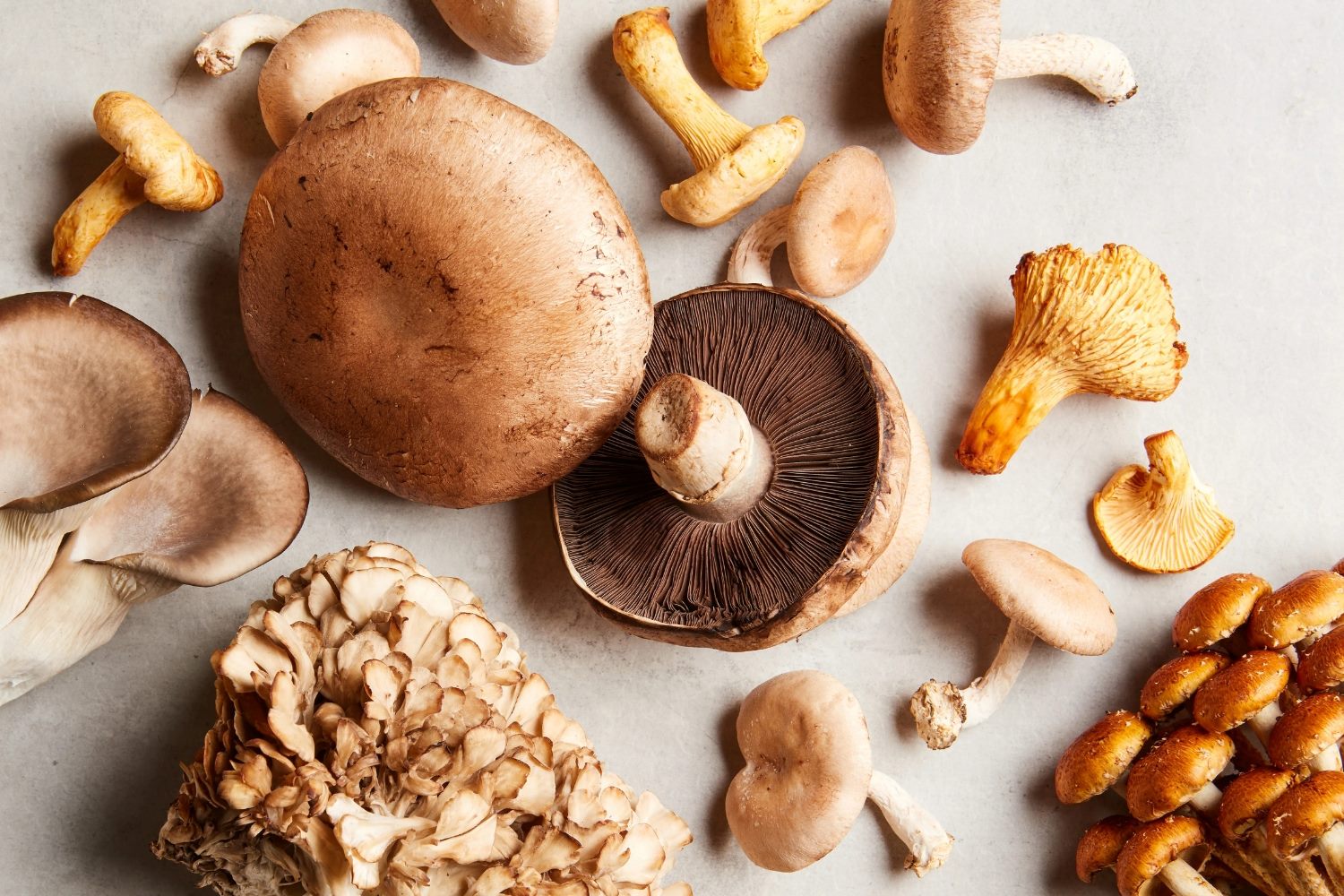Home>Food and Cooking>The Surprising Reason Why People Can’t Get Enough Of Mushrooms!


Food and Cooking
The Surprising Reason Why People Can’t Get Enough Of Mushrooms!
Published: February 6, 2024
Discover the irresistible allure of mushrooms in food and cooking. Uncover the surprising reason behind their widespread popularity and culinary appeal!
(Many of the links in this article redirect to a specific reviewed product. Your purchase of these products through affiliate links helps to generate commission for Noodls.com, at no extra cost. Learn more)
Table of Contents
The Health Benefits of Mushrooms
Mushrooms are not only a delicious addition to meals but also offer an array of health benefits. These versatile fungi are low in calories and packed with essential nutrients, making them a valuable addition to any diet. Here are some of the remarkable health benefits associated with mushrooms:
-
Rich in Nutrients: Despite their low calorie content, mushrooms are a rich source of essential nutrients, including vitamin D, B vitamins, selenium, potassium, and copper. These nutrients play a crucial role in supporting overall health and well-being.
-
Immune-Boosting Properties: Certain varieties of mushrooms, such as shiitake and maitake, contain compounds that have been shown to enhance immune function. These bioactive substances help the body defend against infections and promote a healthy immune response.
-
Antioxidant Powerhouse: Mushrooms are packed with antioxidants, including ergothioneine and glutathione, which help protect the body from oxidative stress and reduce the risk of chronic diseases. Consuming a variety of mushrooms can contribute to overall antioxidant intake.
-
Supports Heart Health: The high potassium and low sodium content of mushrooms can contribute to maintaining healthy blood pressure levels, reducing the risk of cardiovascular diseases. Additionally, the fiber and compounds found in mushrooms may help lower cholesterol levels.
-
Regulates Blood Sugar Levels: Certain types of mushrooms, such as reishi and lion's mane, have been studied for their potential to regulate blood sugar levels. These mushrooms may offer benefits for individuals managing diabetes or seeking to improve insulin sensitivity.
-
Aids in Weight Management: With their low calorie and high fiber content, mushrooms can be a valuable ally in weight management. The fiber content helps promote feelings of fullness, reducing overall calorie intake.
Incorporating a variety of mushrooms into your diet can provide a wide range of health benefits. Whether enjoyed raw in salads, sautéed as a side dish, or incorporated into hearty soups and stews, mushrooms offer a delicious and nutritious way to support overall health and well-being.
The Versatility of Mushrooms in Cooking
Mushrooms are celebrated for their remarkable versatility in the culinary world. They have the unique ability to enhance the flavor and texture of a wide array of dishes, making them a staple ingredient in countless cuisines around the globe. From appetizers to main courses and even desserts, mushrooms can elevate the dining experience in diverse and unexpected ways.
Appetizers and Starters
Mushrooms shine in appetizers, offering a delectable introduction to a meal. Stuffed mushrooms, filled with a savory mixture of herbs, cheese, and breadcrumbs, are a perennial favorite at gatherings and dinner parties. Their bite-sized appeal and rich umami flavor make them an irresistible choice for entertaining.
Main Courses
In main courses, mushrooms take center stage in a myriad of ways. They can be sautéed to perfection and served as a flavorful side dish, or incorporated into hearty pasta dishes, risottos, and stir-fries, adding depth and complexity to the overall flavor profile. Additionally, mushrooms are a popular choice for vegetarian and vegan dishes, often serving as a satisfying meat substitute due to their hearty texture and umami-rich taste.
Soups and Stews
Mushrooms are a beloved addition to soups and stews, imparting a rich, earthy flavor that complements a variety of ingredients. Whether used as the star ingredient in a creamy mushroom soup or added to a robust beef stew for an extra layer of depth, mushrooms bring a comforting and satisfying element to these classic dishes.
Sauces and Gravies
Their versatility extends to sauces and gravies, where they can be finely chopped and incorporated into rich, flavorful sauces to accompany meats, poultry, or pasta dishes. The umami-rich quality of mushrooms adds a savory dimension to these sauces, elevating the overall dining experience.
Desserts
While less conventional, mushrooms can even make an appearance in desserts. The earthy, nutty notes of certain mushroom varieties can be harnessed to create unique and unexpected sweet treats. For example, candied mushrooms or mushroom-infused chocolates offer a surprising and delightful culinary experience for those seeking unconventional flavor combinations.
The adaptability of mushrooms in cooking is truly remarkable, offering endless possibilities for culinary creativity. Their ability to complement a wide range of flavors and textures makes them an indispensable ingredient in the kitchen, catering to a diverse array of tastes and dietary preferences. Whether used as a subtle enhancer or the star of the show, mushrooms continue to captivate chefs and home cooks alike with their unparalleled versatility and culinary allure.
The Unique Flavor Profile of Mushrooms
Mushrooms boast a distinctive flavor profile that sets them apart from other culinary ingredients. Their complex and earthy taste, often described as umami-rich, adds depth and character to a wide range of dishes. This unique flavor profile is attributed to the presence of various compounds, including glutamic acid and guanylic acid, which contribute to the savory, meaty, and slightly nutty undertones that mushrooms are renowned for.
One of the defining characteristics of mushrooms is their ability to absorb and enhance the flavors of other ingredients in a dish. When cooked, they release a rich, savory aroma that permeates the entire culinary creation, elevating the overall sensory experience. This quality makes mushrooms a prized addition to soups, stews, sauces, and stir-fries, where they infuse the dish with a robust and satisfying essence.
The flavor profile of different mushroom varieties varies significantly, offering a diverse spectrum of tastes to explore. For instance, the delicate and subtly sweet notes of enoki mushrooms contrast with the robust and meaty flavor of portobello mushrooms. Meanwhile, shiitake mushrooms impart a distinct smoky essence, while chanterelles offer a luxurious and nutty flavor profile. Each variety brings its own unique nuances to the table, allowing chefs and home cooks to experiment with a myriad of taste experiences.
Furthermore, the texture of mushrooms contributes to their overall flavor profile. While some varieties, such as button mushrooms, have a tender and mild texture, others, like morel or porcini mushrooms, exhibit a firmer, meatier consistency. This textural diversity adds another layer of complexity to the overall culinary experience, making mushrooms a versatile and intriguing ingredient to work with.
The unique flavor profile of mushrooms extends beyond their culinary applications, as they are also valued for their ability to impart depth and complexity to various beverages and condiments. For instance, mushroom-infused broths and stocks are prized for their robust and savory undertones, while mushroom-based seasonings and extracts are used to enhance the flavor of sauces and marinades.
In essence, the unique flavor profile of mushrooms is a testament to their culinary significance. Whether enjoyed as a standalone dish or incorporated into complex culinary creations, mushrooms continue to captivate the senses with their unparalleled taste and aroma, making them an indispensable component of diverse cuisines around the world.
The Environmental Benefits of Mushrooms
Mushrooms offer a myriad of environmental benefits, making them a sustainable and eco-friendly ingredient with a positive impact on the planet. Here are some of the noteworthy environmental advantages associated with mushrooms:
Carbon Footprint Reduction
Mushroom cultivation plays a crucial role in mitigating carbon emissions. Unlike traditional agricultural practices, mushroom cultivation requires minimal space and can thrive in controlled indoor environments. Additionally, the substrate materials used for growing mushrooms, such as agricultural waste and byproducts like sawdust and straw, serve as effective carbon sinks. As a result, the cultivation of mushrooms contributes to carbon sequestration, aiding in the reduction of greenhouse gas emissions.
Waste Management and Recycling
Mushrooms are often cultivated using substrates derived from agricultural and forestry byproducts, which would otherwise contribute to environmental waste. By utilizing these organic materials as growing mediums, mushroom cultivation helps reduce the volume of agricultural waste while simultaneously transforming it into a valuable and nutritious food source. This sustainable approach to waste management aligns with the principles of circular economy, minimizing environmental impact and promoting resource efficiency.
Soil Regeneration and Biodiversity
Mushroom cultivation can positively impact soil health and biodiversity. The process of growing mushrooms involves mycelium, the root-like structure of fungi, which plays a vital role in decomposing organic matter. As mycelium breaks down substrates, it enriches the soil, promoting nutrient cycling and enhancing soil fertility. Moreover, the presence of mycelium can support the growth of beneficial microorganisms in the soil, contributing to overall ecosystem health and biodiversity.
Water Conservation
Compared to many conventional crops, mushroom cultivation requires significantly less water. The efficient use of water in mushroom production minimizes water consumption and helps alleviate pressure on freshwater resources. Additionally, the closed-loop systems employed in mushroom cultivation, such as controlled humidity and recycling of irrigation water, further contribute to water conservation efforts, making mushroom farming a sustainable choice in regions where water scarcity is a concern.
Read more: How To Get Rid Of Mushrooms In Yard
Renewable and Energy-Efficient
Mushroom cultivation is inherently renewable and energy-efficient. The production cycle of mushrooms, from substrate preparation to harvest, occurs relatively quickly compared to many other crops, resulting in a reduced energy footprint. Furthermore, advancements in sustainable farming practices, such as utilizing renewable energy sources and implementing energy-efficient technologies in mushroom cultivation facilities, contribute to minimizing the environmental impact of mushroom production.
In summary, the environmental benefits of mushrooms underscore their significance as a sustainable food source. From carbon footprint reduction and waste management to soil regeneration and water conservation, mushrooms exemplify a harmonious relationship between agriculture and environmental stewardship, offering a compelling model for sustainable food production and ecological resilience.
The Role of Mushrooms in Traditional Medicine
Mushrooms have played a significant role in traditional medicine practices across cultures for centuries, revered for their potential therapeutic properties and medicinal benefits. In traditional Chinese medicine (TCM), mushrooms are regarded as valuable sources of natural remedies, believed to promote health, vitality, and longevity. The rich legacy of mushroom usage in traditional medicine encompasses a wide array of species, each recognized for its unique healing properties and contributions to holistic well-being.
One of the most renowned mushrooms in traditional medicine is the reishi mushroom (Ganoderma lucidum), revered as the "mushroom of immortality" in TCM. Reishi mushrooms have been historically utilized to support immune function, alleviate fatigue, and promote overall vitality. These mushrooms contain bioactive compounds such as triterpenes, polysaccharides, and antioxidants, which are believed to confer various health benefits, including anti-inflammatory and adaptogenic properties. In traditional herbal formulations, reishi mushrooms are often incorporated to enhance resilience and balance within the body, addressing a wide range of health concerns.
Similarly, shiitake mushrooms (Lentinula edodes) hold a prominent place in traditional medicine, particularly in Japanese and Korean healing traditions. Shiitake mushrooms are esteemed for their potential to support cardiovascular health, boost immune function, and provide essential nutrients. The presence of lentinan, a polysaccharide compound found in shiitake mushrooms, has garnered attention for its immune-modulating effects and potential anti-cancer properties. These mushrooms are often integrated into traditional remedies and culinary preparations, serving as a versatile ally in promoting wellness and vitality.
In addition to reishi and shiitake mushrooms, other varieties such as maitake, lion's mane, and cordyceps have also been esteemed in traditional medicine systems for their therapeutic potential. Maitake mushrooms are celebrated for their immune-supporting properties, while lion's mane mushrooms have been associated with cognitive health and neurological well-being. Cordyceps, a unique parasitic fungus, has been utilized in traditional Tibetan and Chinese medicine to address fatigue, enhance stamina, and support respiratory health.
The utilization of mushrooms in traditional medicine extends beyond their direct consumption, encompassing the preparation of tinctures, teas, and extracts to harness their medicinal benefits. Furthermore, modern scientific research has increasingly validated the traditional uses of mushrooms, shedding light on their bioactive compounds and potential applications in integrative medicine and wellness practices.
Overall, the enduring role of mushrooms in traditional medicine reflects their profound impact on human health and vitality, transcending cultural boundaries and standing as a testament to the therapeutic potential of nature's bountiful offerings.












